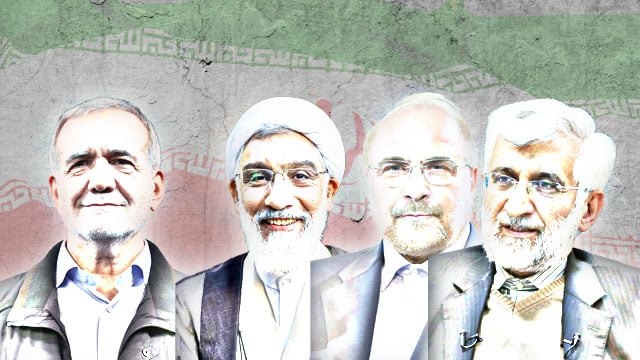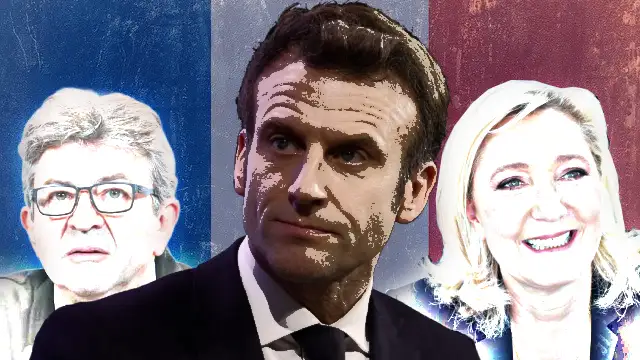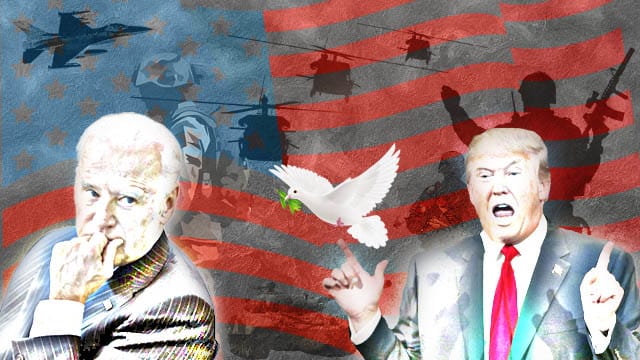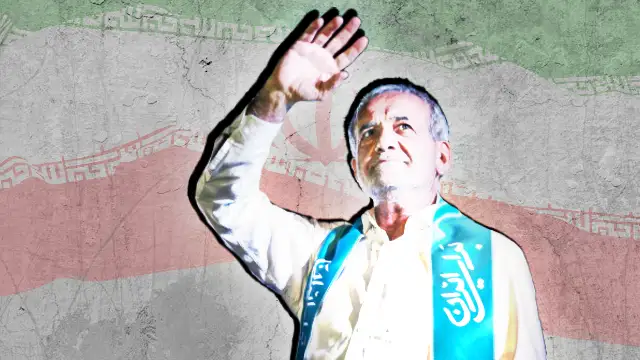On Friday, July 5th, when the Iranian people will step out to cast their votes in the run-up poll to elect their president, the sky may remain partly cloudy, according to weather forecasts, although the day will be hot at 39 degrees Celsius. What else will remain cloudy is the prospects of Iran, given the complex outcome of the snap polls that took place last Friday, June 28th.
Iran’s incumbent president Ebrahim Raisi was mysteriously killed in a helicopter crash on May 19th, which necessitated a snap poll for the second-highest position in the theocratic state. However, the events of Friday portrayed an optics that won’t make the Iranian leaders and clerics happy.
Only 40% of a total of 61m eligible voters turned out to cast their votes on Friday. The election which took place in over 58,000 polling stations across 482 places in the country and in 344 overseas locations, didn’t give a concrete verdict.
Low turnouts in Iran’s presidential elections have been a trend continuing over the years.
This trend of falling voter turnout trend—the graph above shows the trend until the 2021 Presidential Elections—indicates a rising indifference among Iranian voters towards the country’s politics.
Run-up poll
None of the candidates could secure more than 50% of the total votes cast, which is the minimum threshold to be considered a winner. Thus, a run-up poll was announced.
The fact that none of the candidates could secure a comfortable majority isn’t the only disturbing fact for the Islamic Republic’s democratic system, the other biggest concern for the other centres of power is that Saeed Jalili, the man favoured by the supreme leader Seyyed Ali Hosseini Khamenei, was losing to the reformist and moderate candidate Massoud Pezeshkian.
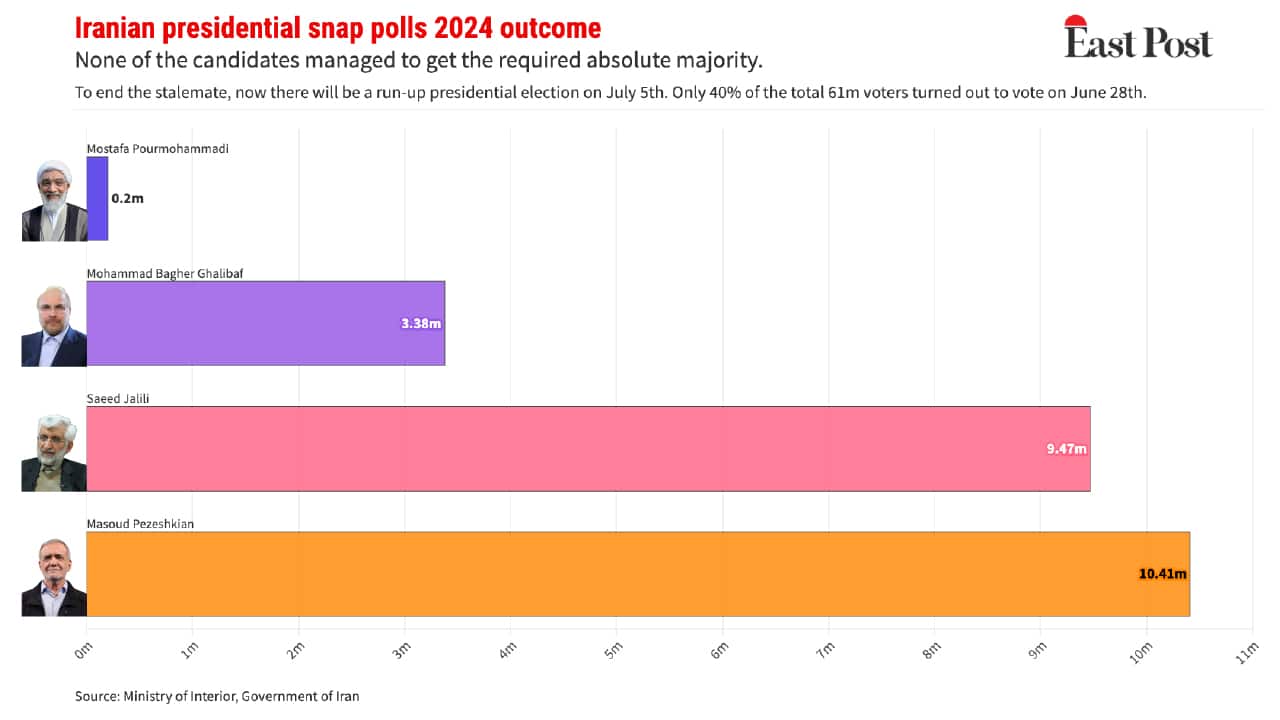
Moderate vs hardliner
Mr Pezeshkian promised a moderate foreign and reformist domestic economic policy following the footsteps of former president Hassan Rouhani. He promised to restart the dialogue with the West on the nuclear deal proposed during Barack Obama’s tenure as the US president.
“Without a well-established and consensual foreign policy, we cannot advance and achieve the country’s economic interests,” he said during a television programme. Outlining his agenda, Mr Pezeshkian emphasised resolving Iran’s economic problems and hinted at restarting the nuclear deal.
“Revival of Iran nuclear deal or JCPOA will be possible with support of Iranians,” he was quoted saying.
He alleged that Mr Jalili has no alternative to the JCPOA. He claimed that once he had confronted Mr Jalili over the JCPOA, “If we do not accept the JCPOA, what is your alternative? But Jalili had no response.”
Mr Pezeshkian also highlighted that the hardliners have a contradictory stance on the JCPOA. During the debate, he asked, “If the JCPOA is bad, why did Trump and Israel want to destroy it and at the same time, in Iran’s parliament, MPs set fire to the JCPOA? What is the difference between them (sic)?”
Mr Jalili emphasises artificial intelligence (AI) to create more employment for the Iranian youth and propel the economic engine, however, he has placed no concrete roadmap.
However, by relying on Mr Raisi’s popularity, Mr Jalili has been vehemently criticising the policies proposed by Mr Pezeshkian.
Taking potshots at Mr Pezeshkian, Mr Jalili asked, “Has the FATF been resolved now? Then how did we manage to buy vaccines? Didn’t they say both the centrifuge and the economic wheel should turn? They went there and reached a deal. What was the result? The other side left the deal!”
Moderate foreign policy problems
While Mr Jalili considers carrying forward the legacy of Mr Raisi, the results showed that there is no consensus among the Iranian people regarding the late president’s hardliner approach towards geopolitics, his obstinate stance on the nuclear deal and his government’s projection of Iran as a regional power.
In this scenario, even though the ailing Mr Khamenei, who reportedly planned to anoint the late president as his successor, will desperately look for a hardliner at the second-highest position, a victory of Mr Pezeshkian can intensify contradiction within the government and thereby weaken Iran’s position in the region.
Moreover, a moderate foreign policy by Iran will allow Washington and its allies to impose their harsh conditions on Tehran, including its ties with Russia and pivotal role in developing the anti-Israel resistance in the Middle East.
Eventually, too much reliance on the West for economic concessions can undo the gains that Iran achieved under Mr Raisi.
However, the other side doesn’t show a rosy picture either.
Lack of economic roadmap
Though Mr Khamenei’s camp promotes the idea of discarding US dollars and trading in local currency, there is not much of a plan on how Iran can increase foreign currency earnings by increasing its exports.
Mr Jalili, apart from AI, highlights the economic scopes created by Russia’s special military operations in Ukraine and hopes that from Africa to Latin America, and Iran’s neighbours, along with the Axis of Resistance create economic opportunities for it.
“Russia used to import $11bn worth of vegetables from Europe; after the conflict, this opportunity arose for Iran to send them vegetables,” he mentioned.
Consider the export scenario of Iran.
The chart below shows that Iran’s total exports fell from $156.12bn in 2011 to $76.42bn in 2015.
After a steep fall during the pandemic to $46.57bn, though the exports rose to $114.99bn in 2023, it’s far behind the 2011 benchmark.
The following chart shows that though in the post-Islamic Revolution period, Iran’s highest export-to-GDP ratio was 31.1% in 2018, it could recover to 28.6% in 2023 after suffering the jolt during the pandemic.
For Iran’s economic development, it’s imperative to have an export-oriented programme.
But what can it export, apart from oil, to build a sustainable foreign currency reserve, isn’t properly outlined.
Ongoing losses
Moreover, the massive discounts Iran offers to countries that buy oil from it, despite the US’s third-party sanctions, was criticised by Majid Ansari, Iran’s Expediency Discernment Council member criticised the discounts in an interview this January.
According to Mr Ansari, by offering discounts ranging between $15 to $30 per barrel, averaging $20 per barrel, Iran is losing around $25m daily, ie, $9bn annually.
He stressed that when the country must have to earn hard currency, it can’t let away this much money in discount.
But neither Mr Jalili nor Mr Pezeshkian has a foolproof plan to save this money. They have so far proposed generic plans to revive the Iranian economy during their televised debate on economic policies.
Way out
Can Mr Jalili wean over the support of Iranian voters, the majority of whom have shown indifference towards the country’s polity?
Can he bring forth an economic policy that can help Iran override the US sanctions by strengthening multilateral ties with the global south allies?
Can Mr Pezeshkian propose a policy where Iran doesn’t have to mortgage its independence in return for the JCPOA? Can he resolve the issues with subsidies, the housing crisis and inflation?
These are some of the questions that are not yet answered. Hence, it becomes quite hard for the Iranian voters to trust them and, therefore, there is a high chance that Iranian elections will exhibit the continuation of the political polarisation.
Tanmoy Ibrahim is a journalist who writes extensively on geopolitics and political economy. During his two-decade-long career, he has written extensively on the economic aspects behind the rise of the ultra-right forces and communalism in India. A life-long student of the dynamic praxis of geopolitics, he emphasises the need for a multipolar world with multilateral ties for a peaceful future for all.

